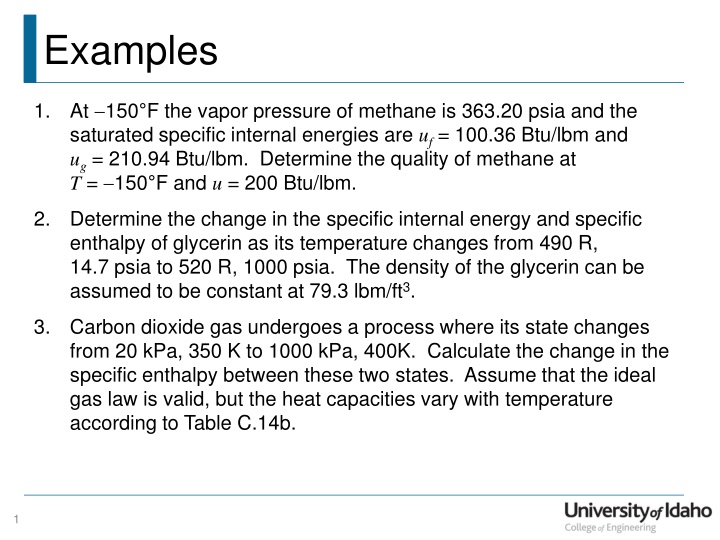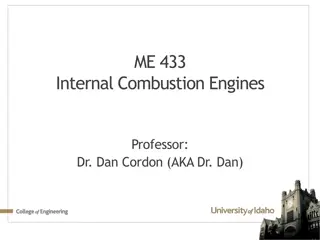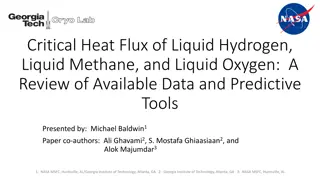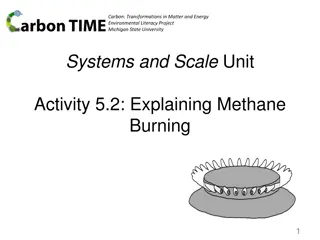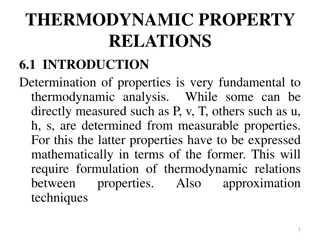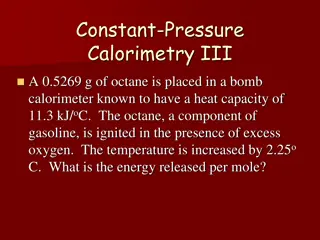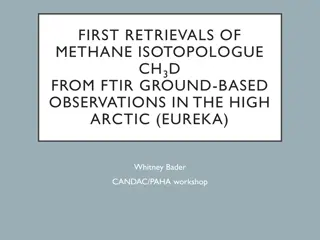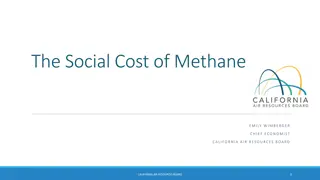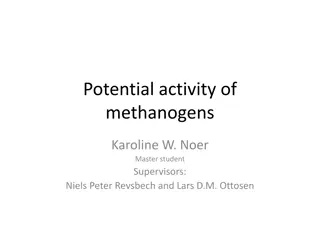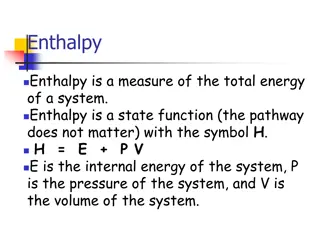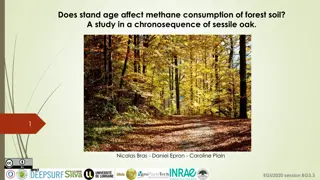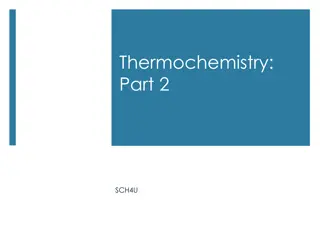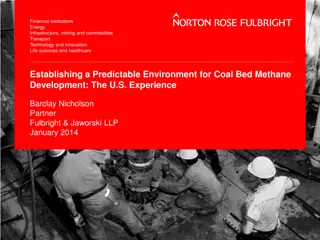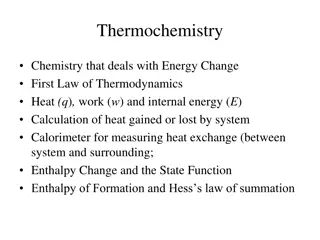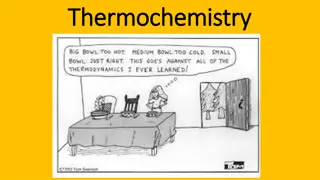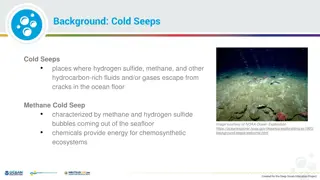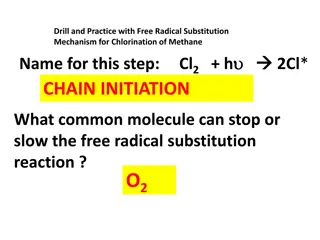Determining Methane Quality and Specific Enthalpy Changes
Given the properties of methane at 150°F, determine the quality at a specific internal energy. Calculate the change in specific internal energy and specific enthalpy of glycerin as it undergoes a temperature change. Also, find the change in specific enthalpy for carbon dioxide gas in a varying temperature process. Explore these thermodynamic calculations with detailed steps and formulas.
Download Presentation

Please find below an Image/Link to download the presentation.
The content on the website is provided AS IS for your information and personal use only. It may not be sold, licensed, or shared on other websites without obtaining consent from the author.If you encounter any issues during the download, it is possible that the publisher has removed the file from their server.
You are allowed to download the files provided on this website for personal or commercial use, subject to the condition that they are used lawfully. All files are the property of their respective owners.
The content on the website is provided AS IS for your information and personal use only. It may not be sold, licensed, or shared on other websites without obtaining consent from the author.
E N D
Presentation Transcript
Examples At 150 F the vapor pressure of methane is 363.20 psia and the saturated specific internal energies are uf= 100.36 Btu/lbm and ug= 210.94 Btu/lbm. Determine the quality of methane at T= 150 F and u= 200 Btu/lbm. 1. 2. Determine the change in the specific internal energy and specific enthalpy of glycerin as its temperature changes from 490 R, 14.7 psia to 520 R, 1000 psia. The density of the glycerin can be assumed to be constant at 79.3 lbm/ft3. 3. Carbon dioxide gas undergoes a process where its state changes from 20 kPa, 350 K to 1000 kPa, 400K. Calculate the change in the specific enthalpy between these two states. Assume that the ideal gas law is valid, but the heat capacities vary with temperature according to Table C.14b. 1
At 150F the vapor pressure of methane is 363.20 psia and the saturated specific internal energies are uf= 100.36 Btu/lbm and ug= 210.94 Btu/lbm. Determine the quality of methane at T= 150 F and u= 200 Btu/lbm. 1. ( ( ( ( ) ) ) ) = = = = + + + + = = = = + + + + 1 v x v xv v xv f g f fg 1 u x u xu u xu f g f fg 1 h x h xh h xh f g f fg 1 s x s xs s xs f g f fg ( ) u u u u u u 200 100.36 Btu/lbm 210.94 100.36 Btu/lbm f f = + = = = = 0.901 90.1% = u u xu x ( ) f fg u fg g f 2
2. Determine the change in the specific internal energy and specific enthalpy of glycerin as its temperature changes from 490 R, 14.7 psia to 520 R, 1000 psia. From Table 3.5 in the textbook you find that cglycerin = 0.576 Btu/lbm-R. The density of the glycerin can be assumed to be constant at 79.3 lbm/ft3. Assumption: The glycerin is incompressible. Then ... du cdT = = du cdT T ( ) 2 = u u cdT c T T 2 1 2 1 T ( ) 2 T = u u cdT c T T 1 2 1 2 1 Btu lbm-R Btu lbm ( ) T = 520 490 R = 1 0.576 17.28 u u 2 1 Btu lbm-R Btu lbm ( ) = 520 490 R = 0.576 17.28 u u Table 3.5 2 1 Table 3.5 = = + h u pv + 2 = = + h u pv + ( ( ) ( ( ( + ( = ) ( + p v h h u 2 2 p v u h u 1 1 p v p ) 1 u ) ( ( ( + ) Units will get you + 2 1 2 h 1 h u u 1 1 p v p 1 2 2 2 1 ) 1 ) + = 2 + h h u v p ( u = ) 2 1 2 h 1 2 1 v p 2 2 1 ) ) p u p u ( ) 1 ) = 2 2 1 h h u u p p 2 1 2 h 1 h 2 1 2 1 2 2 lbf in lbm 144 in ft ( ) 1000 14.7 Btu 17.28 lbm 2 lbf in lbm 144 in ft ( 2 ) 2 1000 14.7 Btu lbm 1 h Btu 2 Btu lbm = + = 17.28 h 19.58 Btu h h Btu lbm = + = 2 1 19.58 778.16 ft-lbf 79.3ft 2 778.16 ft-lbf 3 79.3ft 3 3
3. Carbon dioxide gas undergoes a process where its state changes from 20 kPa, 350 K to 1000 kPa, 400K. Calculate the change in the specific enthalpy between these two states. Assume that the ideal gas law is valid, but the heat capacities vary with temperature according to Table C.14b. Do the simple case first. What if specific heat doesn t change with temperature? Table C.13b shows ?? for CO2 is 0.845 kJ/kg-K 2 1= ?? (?2 ?1) ?? = 0.845 50[?] ?? ? ?? ?? = 42.25 4
3. Carbon dioxide gas undergoes a process where its state changes from 20 kPa, 350 K to 1000 kPa, 400K. Calculate the change in the specific enthalpy between these two states. Assume that the ideal gas law is valid, but the heat capacities vary with temperature according to Table C.14b. From Table C.14b for carbon dioxide, K 100 T kJ 3.7357 30.529 = + + = = 0.5 2 4.1034 0.024198 c c p p kmol-K T T 2 2 = = = dh c dT h h c dT h h c dT 2 1 2 1 p p p T T 1 1 = = 100 100 T dT d ( ) 2 2 = = 3.7357 30.529 + + 0.5 2 100 100 4.1034 0.024198 h h c d d 2 1 p 1 1 = 4 1.5 2 3 2 = 3.7357 + + 100 30.529 4.1034 0.024198 h h 2 1 1.5 2 3 = 3.5 1 kJ kJ ( ) = 5.57 95.40 = 100 11 2017 h h 2 1 kmol-K kmol-K kJ kmol 44.01 kg kJ = = 2017 45.83 h h 2 1 kmol-K kg-K Table C.13b Note: units on should be kJ/kmol, and should be kJ/kg 5
